Etxebarri
By Jessica – September 3rd, 2013
Amongst my haphazard collection of recipes scribbled and ripped from sundry sources are two pages I tore out of Gourmet magazine (remember that?) back in 2009. They’re the first pages of an article called “Smoke and Miracles” about a restaurant in Spain named Etxebarri. I’m not sure why I didn’t save the whole article—maybe because I didn’t have to. As soon as I finished reading it, I knew that Etxebarri was someplace I would have to visit someday, and I suspect I saved those first pages solely to remind myself of how to spell the restaurant’s name (incidentally, it looks more complicated to pronounce than it is: etch-eh-bahr-ee).
The minute I learned of Etxebarri’s existence, this small restaurant in an obscure Basque village shot to the top of my list of dream destinations. It sat there alongside Dubrovnik and Patagonia and Hong Kong, places that tug insistently at the strings of my imagination, Wanderlust-induced itches that demand to be scratched. I blatantly romanticize these locations, allowing them to take mythic proportions in my mind, while at the same time reminding myself that most places on my dream list probably can’t live up to my expectations of them.
But some can.
The first thing to say about Etxebarri is that it takes some effort to get there. It’s located in the minuscule mountain village of Axpe, roughly 50 kilometers from Bilbao or 75 from San Sebastian (the two places you’re most likely to be if you’re visiting the Basque Country). It’s not on the way to anywhere, so if you want to dine at Etxebarri, you have to make a special trip to reach it. Most folks rent a car and drive themselves, and stories abound of people getting lost on the twisty mountain roads in the dark while attempting to find the place. Basically, eating at Etxebarri takes time and planning.
That said, it’s not quite the epic journey it’s often made out to be. Tip number one: Go for lunch instead of dinner. That way you get to see the beautiful countryside and, if you’re driving, you’re less likely to get lost on a dark road. Tip number two: Don’t drive. Though it takes a bit longer, it’s easy enough to reach Etxebarri by train and taxi (details at the end of this post). That way you get to see the beautiful countryside and enjoy some great wines with your lunch (and take a nap on your way back to San Sebastian or Bilbao—because after all the food and wine, you are going to want a nap).
The other thing to say is that while you could justifiably call Etxebarri the best grill restaurant in the world, that descriptor doesn’t fully express what makes the place so special. Yes, the restaurant makes it own charcoal with different varieties of wood, and yes, absolutely everything is cooked either on a grill (designed by the chef, Victor Arguinzoniz ) or in a wood-fired oven, and yes, the tasting menu culminates in a tremendous, charred, bone-in rib steak that is pretty much the epitome of Grilled Meat. But there is something in the confluence of location and ethos and ingredients and preparation that lends Etxebarri a sense of timelessness and enchantment.
It was the grilling that drew me there, though. I have a primal affinity for all things smoked or charred, and the prospect of enjoying 10+ courses of barbecued food in a rustic Basque setting was too much for me to resist. Dining at Etxebarri appears to be something of a Goldilocks situation: Some reviewers feel that because absolutely everything is touched by smoke there’s a “samey-ness” to the food, while others have complained that the smoke effect is too subtle in some courses. As for me, I was the happy little girl presented with the perfect bowl of porridge, since I thought the degree of smokiness (which ranged from the merest hint to a full-on woodsmoke infusion) varied appropriately for each ingredient.
And what ingredients they were. The meal was a tour around the coastal waters and countryside of Spain: Cantabrian tuna and Mediterranean prawns, Salamancan pork and Galician beef, mushrooms and milk and berries right from Etxebarri’s doorstep. The menu at Etxebarri is famously to-the-point—no inscrutable descriptions of overwrought concoctions, just one or two words of explanation: Butter. Oyster. Beef Chop.—and this perfectly reflects the food that’s served. Each ingredient is plucked from the land or sea, kissed by woodsmoke and then placed on your plate, where it is allowed to speak for itself. Boundary-pushing culinary experiments and “molecular gastronomy” certainly have their place, but that place is not Etxebarri.
So, the details: We arrived a good 45 minutes early for our 2:00 p.m. reservation but were seated immediately in the comfortable, spacious dining room. Several years ago, there was no set tasting menu at Etxebarri and the only person who spoke English was the Australian sous chef. That’s all changed now that Etxebarri is has become a destination. We were presented with English menus straight away (tasting menu and à la carte), and everyone we encountered (save the chef himself) spoke English to some extent. There was also an English- (and French-)speaking sommelier who was happy to pair wines with the courses for us. We went for the tasting menu, naturally, so we could try as many different things as possible. We didn’t make any changes to the menu, but the restaurant is open to swapping things out, or even adding things from the à la carte menu if you so desire.
The meal started with big hunks of warm, crusty spelt bread and a quartet of appetizers:
Butter of goat’s milk with black salt. It tasted like smoked cheese but had a light, unctuous texture - perfect for that crusty bread.
Crackers with thinly sliced mushrooms, homemade chorizo, and house-cured anchovies on toasted bread. For all of their delicacy, the mushrooms were packed with earthy flavor (like all of the mushrooms we ate in Spain ). The chorizo was spicy, sweet and tender, with the perfect ratio of meat to fat; it melted in the mouth. The anchovies were plump and salty, with just a hint of smokiness amplified by the bread, which had been toasted on the grill. After these morsels, my appetite was thoroughly whetted.
Then we moved on to the main courses:
Tomato and white tuna. The only way to express how much I loved this dish is to say that just looking at this picture makes me want to cry and lick the computer screen at the same time. From the moment the plate was set in front of me and I caught a gentle whiff of woodsmoke and olive oil, I was smitten. And when I took my first bite, I did actually moan. The fatty tuna was soft and pink inside, infused with a whisper of smoke, and set off by the crunch of the pink salt and the fruity olive oil. The fish rested on a hemisphere of salted tomato which provided a welcome hit of light acidity. Maybe because it was first “proper” dish of the meal, or because I adore tuna/tomato/salt/smoke/olive oil anyway, or because both the ingredients and the preparation were impeccable—for whatever reason, I remember this as being one of the best things I’ve ever eaten.
Oyster and seaweed. Don’t let the appearance of foam deceive you—we haven’t entered molecular territory here. This dish consisted of a single fat oyster served in its shell on a small bed of seaweed with foam which, as I understand it, was simply the oyster juice which had been whipped by hand. The oyster had been just warmed through, and the seaweed accentuated its natural brininess. After managing to spear the oyster with my fork, I picked up the shell and (quietly) slurped out the rest of its contents, basking in the flavors of the sea.
Prawns from Palamos. Oh, these prawns. They arrive peacefully nestled together, glistening pink on the plate—and you pick them up, rip them apart and suck their brains out. You’re encouraged to get down and dirty with them; sure, you can try to daintily disassemble them with a knife and fork, but you’d be missing out on some of the visceral pleasure of eating—and anyway, you get a warm cloth soaked in ginger water for cleaning up afterwards. It’s tedious to harp on about everything being “perfectly cooked”, but honestly, a truly perfectly cooked prawn is a rare thing of beauty, and these prawns were faultless. The shells were licked by fire and dusted with salt, and the meat inside was sweet, succulent and not at all mushy. I was sorely tempted to lick the shells myself because that salty, smoky flavor was so addictive. Jeremy declared these to be the best prawns he’d ever had, and I’m not inclined to disagree.
Sea cucumber and white beans. Having never had sea cucumber before, I had nothing to compare this dish to—but if all sea cucumber is like this, then I’m a fan. It had a springy/chewy/crunchy texture with ribbons of charring along the edges (my favorite bit) and was served with a scattering of firm white beans dressed with olive oil and salt. Cooked white beans are a staple in our household, so despite the unfamiliarity of the sea cucumber, this dish had a comforting, homely feel.
Baby squid with caramelized onion and its ink. Here we go with the “perfectly cooked” again. Squid can be a tricky customer, as anyone who’s suffered through a bowl of rubber bands disguised as calamari will tell you. This squid was firm but not chewy at all, and its mild flavor was complemented by the sweet caramelized onion and the swirl of squid ink that offered a dark taste of the sea. Though I like squid well enough and this dish was prepared beautifully, it was probably the least memorable course for me.
Mushrooms and eggplant. Nothing about either the look or the description of this dish can do justice to how it tasted. It tasted…elemental. It was earthy and ethereal at the same time, deeply smoky and juicy, with intensely savory mushrooms and fire-roasted eggplant so soft it dissolved on your tongue. Jeremy said this dish had something Japanese about it, and he’s right; in its (apparent) simplicity and its respect for the essence of each ingredient, it reminded me of the extraordinary food we had in Kyoto. It was just a few beautiful bites and then it was gone. Another one of my favorite courses.
Red sea bream and vegetables. Just as the six preceding courses are starting to hit bottom—a whole fish shows up! This was a grilled red sea bream carved at the table, drizzled in oil speckled with fried garlic and herbs, and served with teeny-tiny fresh vegetables from the garden. The fish was meaty, flaky and remarkably moist, and I sopped up every last bit of that garlicky oil. When we got a quick view of the kitchen after the meal, I was pleased to see that Chef Arguinzoniz uses “fish baskets” for the grill that are similar to the ones we use on our BBQ. And if I am ever able to cook a fish this well on our BBQ—well, I suppose then I can open my own restaurant.
Beef chop. Is there any more stunning way to round off a multi-course tasting menu that with an entire rib of beef for two? No, there is not. This is what everyone talks about: the txuleta, the chop of Galician beef that arrives on the bone, charred on the outside, rare on the inside (you’re not asked how you want it cooked—because how else could you possibly want it cooked?), seasoned with nothing but salt and the smoke that enveloped it on the grill. I think it’s fair to say that Jeremy and I have become something of beef rib aficionados over the past few years; we cook them a lot (way more often than is healthy, I’m sure), so we know what we like—and boy, did we ever like this. Ruby meat and golden marbling, with the iron tang and firm bite of properly aged, grass-fed beef, the richness cut by a simple lettuce and onion salad served on the side. We ate every last scrap of meat, and I valiantly resisted the urge to pick up the bone and gnaw on it (not long after, a guy at the next table did just that and I kicked myself for my misplaced decorum). I think I’ve actually eaten too many steaks in my life to be able to say which is “the best steak I’ve ever eaten”, but I will say that in this context, on this day, this beef chop was flawless.
Refreshing watermelon. “Cut” blueberries. I was ready to take a nap on the table at this point, but the thirst-quenching watermelon juice and the zingy blueberry ice cream between light, crunchy wafers revived me; they were a welcome refreshment after so many deeply savory courses. Blueberries are a favorite fruit of mine, and ice cream sandwiches are a happy childhood memory, so I was delighted with this first sweet course.
Reduced milk ice cream with red fruit infusion. The milk for this ice cream was reduced over a wood grill, I believe, which gave it a smokiness comparable to that of the smoked butter at the start of the meal. It had a caramelized savoriness about it, too, which was cut nicely by the accompanying tart berry sauce. While not as “challenging” as the Gorgonzola ice cream I had at Akelarre the next day, this was still a very rich and unusual dish—but an addictive one, too: I would take bite, think “whoa, that’s intense”, take a little sip of sweet sherry, then think “I need another bite of that ice cream”…and so on, until I had scraped my bowl clean.
Mignardise. And just in case we weren’t entirely stuffed by the time we finished our 10+ courses, we were given one final plate bearing two types of chocolate bon bon (bourbon and praline) and a sweet, dense almond muffin—the perfect accompaniment to the short, strong coffees we desperately needed by that point.
And finally, a good three hours after it started, our epic meal came to an end. While we waited for a cab to take us back to Durango, we were given a glimpse of the remarkably tiny kitchen and a chance meet the kindly chef himself. I wanted to tell him how long I had been looking forward to eating in his restaurant and how much I had enjoyed it and how the experience was everything I had hoped it would be, but I lacked the Spanish or the Basque to do so. In the end, I had to content myself with nothing more than a smile and a bashful eskerrik asko. I’ll have to learn a bit more for the next time I go—because there has to be a next time.
Public transportation from San Sebastian:
From the Amara train station in San Sebastian (aka Donostia), take the Euskotren commuter line in the direction of Bilbao, which leaves once an hour. Get off in Durango, which is two hours from San Sebastian. When you leave the station in Durango, you’ll see a playground and a taxi rank beyond it. We walked up to a taxi driver who said something to us in Basque, and when we responded with bewildered stares, he said, “Restaurant? Etxebarri?”—so, yeah, they know the score. The taxi ride to Etxebarri took about 15 minutes and cost roughly 20 euros. When we finished lunch, the restaurant called a cab to take us back to Durango, where we hopped on the train back to San Sebastian. We arrived in the city just in time to take a quick nap and then hit the pintxos bars (yes, even after a mammoth 10-course lunch, we managed to continue eating until after midnight).
I read a lot of blog posts and reviews about Etxebarri online, but it was on the Global Gastronomette’s site that I found the most encouraging and detailed information about getting to Etxebarri by train and taxi—so, thank you, Global Gastronomette!
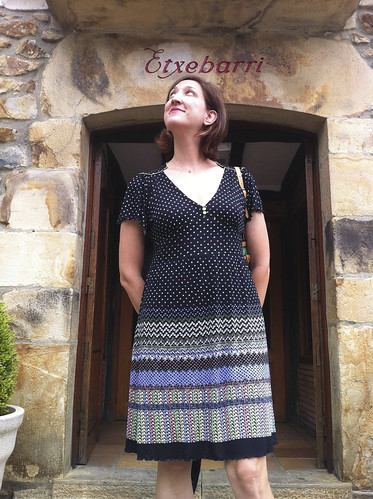

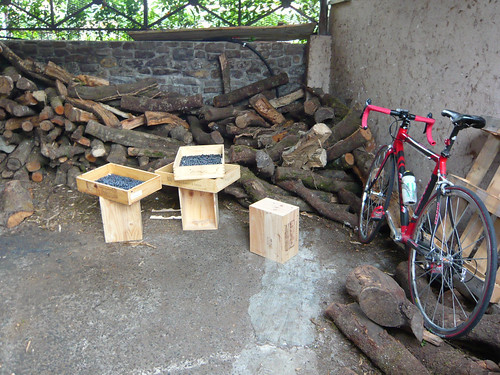
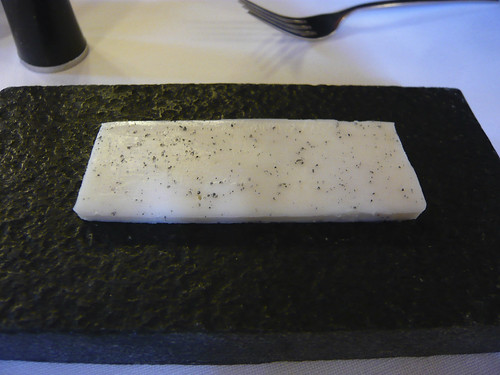
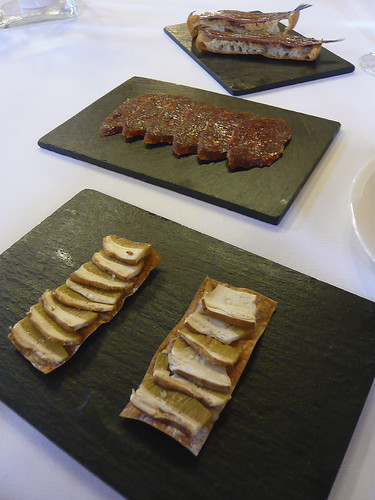




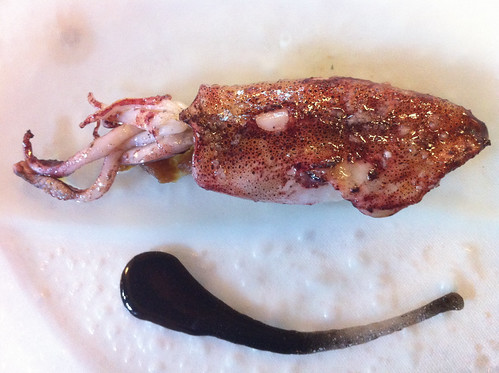
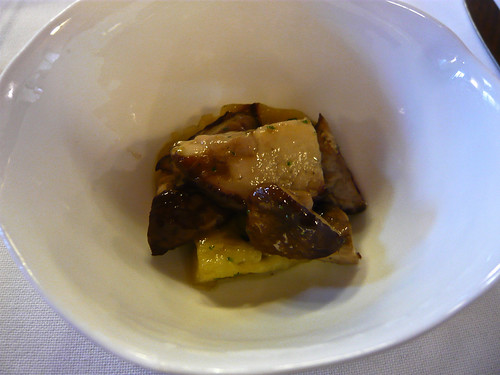

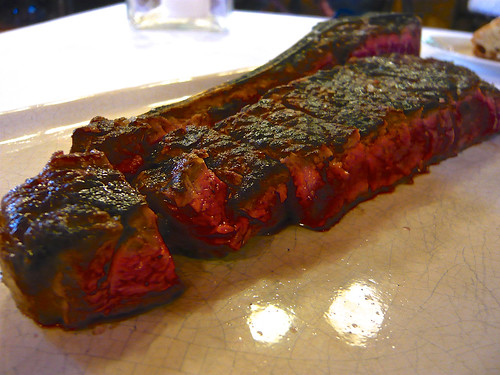

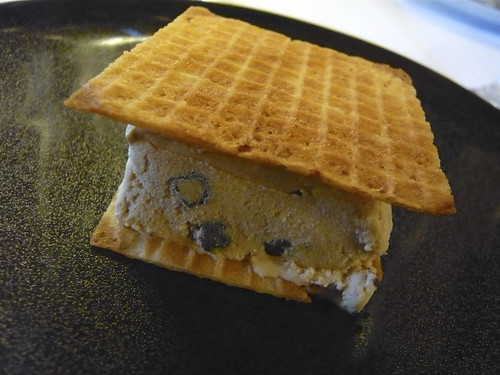
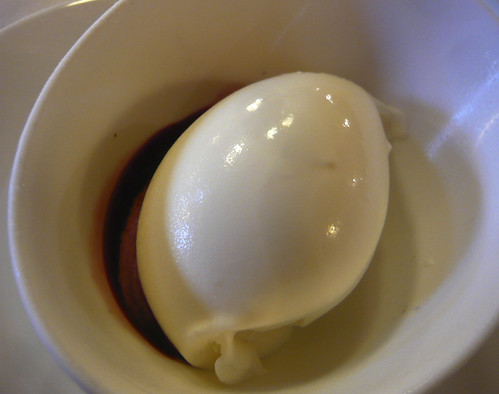


Comments
Sorry. Comments are closed.